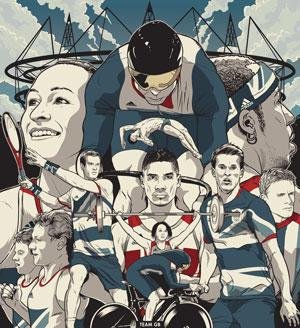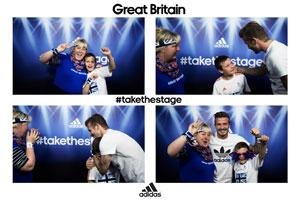Since it was established in Germany in 1949, by Adolf Dassler, Adidas has been synonymous with the sporting industry. Today, Adidas is a global public company and is one of the largest sports brands in the world. It is a household brand name with its three stripes logo recognised in markets across the world.
The company’s product portfolio is vast, ranging from state-of-the-art sports footwear and clothing to accessories such as bags, watches, eyewear and other sports-related goods and equipment. Employing over 46,000 people worldwide, the Adidas Group consists of around 170 subsidiaries including Reebok, TaylorMade-Adidas Golf, Rockport and CCM-Hockey. The Group’s headquarters are in Herzogenaurach, Germany. In the second quarter of 2013, the Group’s revenue was €3.383 billion.

The Adidas brand is built on a passion for sports excellence and innovative design to help athletes perform to the best of their ability. It is, therefore, no surprise that Adidas has supported many iconic athletes to achieve great things at the Olympic Games. In the UK, Adidas has partnered and supplied Team GB since 1984. The company’s heritage with the Olympic Games dates back to the Games in Amsterdam in 1928 when Adidas running shoes were debuted. Footwear and clothing by Adidas have been seen on athletes at every Olympic Games since. In fact, all British medal-winning athletes at the last 8 Olympic Games wore Adidas products.
There are countless historic sporting achievements that have taken place in Adidas products. These include:
- Jesse Owens’ 4 gold medals in Berlin 1936
- Cassius Marcellus Clay (Muhammad Ali) taking gold in the boxing light-heavyweight division at Rome 1960
- Dick Fosbury’s revolutionary new back-first high jump technique at Mexico in 1968, known as the ‘Fosbury Flop’
- Gymnast Nadia Comaneci’s perfect 10 at Montreal 1976.
This case study demonstrates how Adidas used innovative marketing strategies in its sponsorship deal with the London 2012 Olympic Games to engage with young consumers in the UK and across the globe.
The marketing mix
For most organisations, the marketing function is vital for survival. The Chartered Institute of Marketing defines marketing as:
‘Marketing is the management process responsible for identifying, anticipating and satisfying consumer requirements profitably.’
This definition outlines the key purposes of the marketing function. These are:
- to compete in a competitive marketplace
- to identify and anticipate consumer requirements and then satisfy these requirements
- to make a profit.
As a market-orientated organisation, Adidas continuously identifies and reviews consumers’ needs to ensure its products meet these needs. It aims to exceed customer expectations by adapting its product portfolio to meet the changing needs of consumers. It is this focus on its customers, teamed with product and marketing innovation, that plays a key role in Adidas’ success.
Every organisation must look at its marketing in relation to the marketing mix. The marketing mix often referred to as the 4Ps, is a means of assessing how to balance the elements of the mix in order to meet customers’ needs. The elements include:
- the right product
- sold at the right price
- in the right place
- using the most suitable form of promotion.
No two businesses are identical, as such, every organisation must decide on its own balance of the 4Ps to suit its consumers’ needs. There are many internal and external factors that will influence an organisation’s marketing mix. Key factors include the size of the business, the markets it operates in and available resources.

For a global organisation like Adidas, its marketing mix is tailored to specific markets. This is known as international marketing as it takes cultural and social differences into account when planning marketing activity. Sports marketing is a key focus of Adidas’ marketing mix. The growing popularity of sports as entertainment has led to a huge increase in sports marketing. The founder of Adidas was one of the first people to see the potential of this form of marketing when he sponsored the FIFA World Cup back in 1978. Sponsorship involves a business paying to be associated with another organisation, event or TV programme.
Like many new developments, the sports marketing function has changed dramatically since its introduction. Just consider Sony’s first-ever Walkman in 1979 to today’s iPod. The same dramatic difference is evident in the sports marketing arena with sponsorship deals now worth tens of millions of pounds. Rather than simply trying to gain positive associations with particular sports, companies use sports marketing to drive the brand and increase sales.
Marketing strategies

Within the marketing function of any organisation, there will be key goals, or objectives, to be achieved. For example, increasing the market share by 3% or entering a new market overseas. To achieve these marketing objectives requires a plan that details the actions needed. These plans are referred to as marketing strategies. A key challenge for Adidas’ marketing strategies is finding innovative ways to inspire and engage its 14-19-year-old target audience.
For Adidas, London is a key focus for the sportswear market, for both performance sportswear and sports fashion. This market sets more trends than anywhere else in the country. London 2012 gave Adidas a platform to target this audience but with a global reach. The sponsorship deal obtained by Adidas was the broadest set of sportswear rights in Olympic history. It became the Official Sportswear Partner of the London Games and the exclusive licensee of all branded (Adidas + London 2012) and event branded (London 2012 only) clothing. From these rights, Adidas set four key marketing objectives:
- To ensure a clear association as Sportswear Partner of London 2012, Team GB and Paralympics GB.
- To engage and excite the 14-19 year old audience in order to drive brand preference in the UK.
- To deliver a Licensed Product Return on Investment (ROI) (branded and event branded licensee rights).
- To become the most talked about sports brand in 2012.
A major aspect of this sponsorship deal was the athletes’ kit. The kit provided the opportunity to be innovative and excite the target audience whilst creating products to meet commercial sales targets. Market research undertaken by Adidas showed the youth audience wanted something ‘untraditionally British’. Designer Stella McCartney fulfilled this brief with her deconstructed Union flag design.

Preparations to equip the team started 2 ½ years before the Games were due to start. Over 550 athletes were fitted for over 680 items of kit. This meant the marketing activity for the campaign also started long before the Games in 2012. A photo booth shoot captured every athlete in their kit. These images were used to create excitement around the Team GB kit product launch.
Promotion
All elements of the marketing mix are important. However, in increasingly competitive markets innovative methods of promotion can create a competitive advantage. Promotional activity is used to communicate with consumers about the brand and its products. As there were more than 50 London 2012 sponsors, Adidas needed to ensure it communicated the right messages, at the right time, through the appropriate channels for its target audience. It aimed to create national support for Team GB through its ‘Take the Stage’ campaign.
The acronym AIDA is useful when planning promotional activity, promotion should aim to:
- initiate awareness among consumers
- generate interest for and desire to have the product
- ensure action to purchase.

There are many different methods of promotion. Above-the-line promotion refers to traditional methods of advertising, such as print adverts in magazines and newspapers, billboards or online and TV advertisements. This form of promotion is expensive. As mass audiences become harder to reach through advertising, for example, an increasing number of people record TV and fast-forward the adverts, innovative methods of below-the-line activity is becoming increasingly important to engage the audience.
Above-the-line activity for Adidas’ campaign included TV adverts that showcased the best UK talent across sport, street and style. The adverts contained carefully planned product placement. Amongst those featured were David Beckham, Wretch 32 and Derrick Rose. In addition to a significant outdoor media spend, Adidas featured artist impressions of athletes on 17 London Metro front pages.
TV adverts featuring athletes such as Jessica Ennis and Tom Daley were used to rally support for Team GB. In these adverts, athletes shared their intimate goals, fears and thoughts, something which was dramatically different to other sponsors of London 2012.
In contrast, the below-the-line promotion aims to reach more targeted groups of consumers. For example, through sponsorship deals, direct marketing, public relations and social media. The below-the-line promotion targeted at the youth audience was a key method for Adidas to achieve its marketing objectives. It used a wide range of promotional activities to create deeper engagement with its audience, mixing traditional media with innovative use of social and digital channels. The scale of the activation of this campaign was an industry first.
Its TV adverts aimed to drive consumers to a website where they could demonstrate their talents for a chance to meet their idols. Through ‘Project 32’, Adidas had already rewarded 32 talented youngsters in London with the chance to meet leaders in their chosen fields, such as the sporting and musical industry, giving undiscovered talent the chance to ‘Take the Stage’.

Social media played an integral part in Adidas’ campaign. For example, on Twitter #takethestage became the summer trend for supporting Team GB. Videos on YouTube created hundreds of millions of views, including a video of Team GB athletes singing along to Queen’s ‘Don’t Stop Me Now’. In addition, a large photo booth was set up at Westfield shopping centre in Stratford. Members of the public then entered the booth to show support for Team GB. Videos of people’s reactions to David Beckham making a surprise appearance received 3.2 million views, as well as international TV coverage.
Measuring a promotional campaign
Promotional activity is very expensive. Organisations want to see a return on investment (ROI) for the money they spend on a promotional campaign. Sponsorship of London 2012 was no exception. Every aspect of its promotional campaign, both online and offline, was continuously monitored and measured. This enabled Adidas to demonstrate that becoming the Official Sportswear Partner of the London Games and the exclusive licensee of all branded (Adidas + London 2012) and event branded (London 2012 only) apparel was cost-effective.
Throughout the campaign, Adidas monitored all of its media coverage. This data was then used to establish whether the marketing objectives had been achieved. The table below demonstrates the significant return achieved through this campaign and how Adidas successfully achieved its marketing objectives.

Conclusion

An organisation’s marketing mix is its own way to uniquely position the brand and drive sales. For Adidas, this includes understanding what its consumers want and producing innovative products that fulfil these needs. Using innovative methods of sports marketing, on a scale never before seen in the industry, enabled Adidas to target the youth audience in London whilst also having a global reach through social media and online promotion.
Sponsorship deals such as Adidas’ heritage with the Olympic Games are very expensive. However, as this case study shows, well-planned marketing strategies with clearly defined objectives can offer a way of creating deeper engagement with consumers. Partnering the brand with London 2012, Team GB and the Paralympics engaged Adidas target consumers and created huge amounts of support for Team GB before, during and after the Games.
